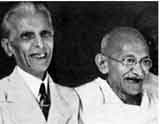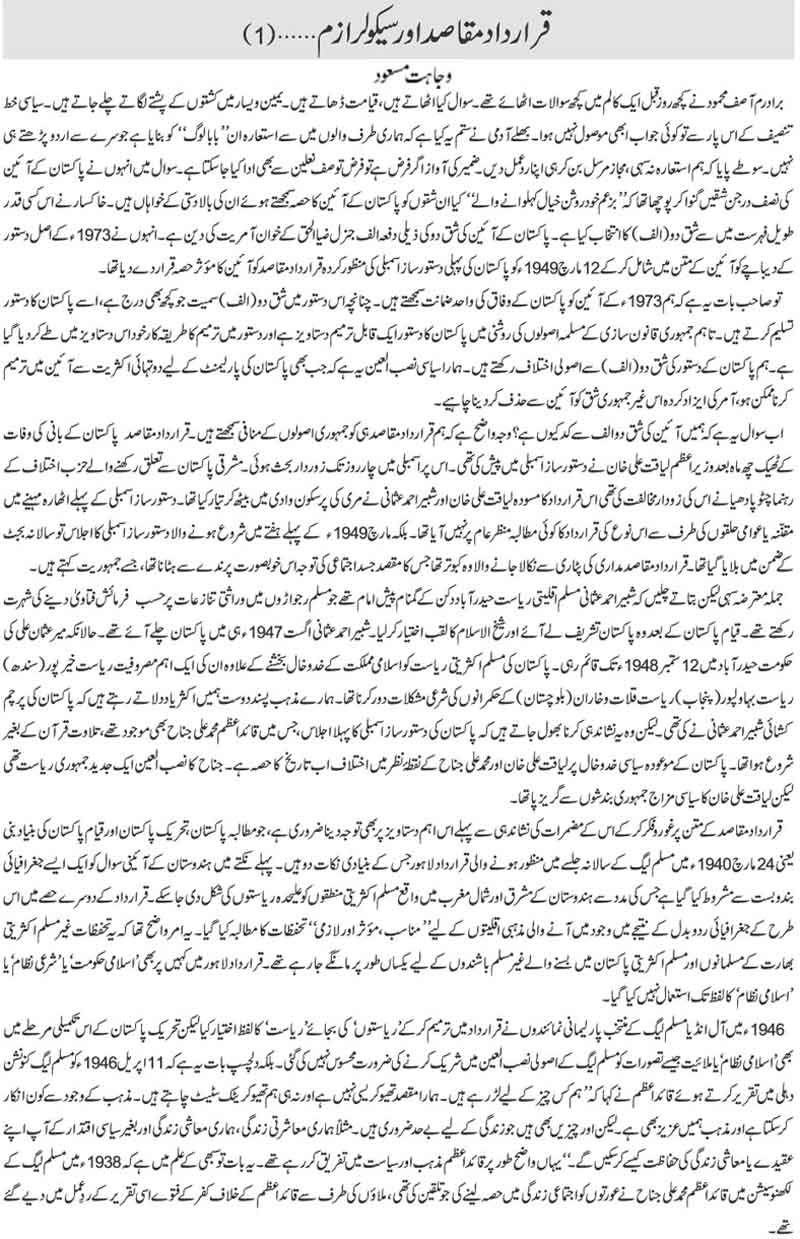| Urdu Section | |
| 28 Mar 2010, NewAgeIslam.Com |
OBJECTIVES RESOLUTION AND SECULARISM--Part I | ||
 A few days ago brother Asif Mahmood raised some questions. He does not raise questions, rather raises a storm. Of late no response has been received from the other side of the political dividing line. The irony is that from among the people on this side, the gentleman has targetted those 'babalog' who do not read Urdu in the first place. It was decided that though I am not the target, I should respond because the voice of conscience should be responded. A few days ago brother Asif Mahmood raised some questions. He does not raise questions, rather raises a storm. Of late no response has been received from the other side of the political dividing line. The irony is that from among the people on this side, the gentleman has targetted those 'babalog' who do not read Urdu in the first place. It was decided that though I am not the target, I should respond because the voice of conscience should be responded.
In his questions he had quoted half a dozen sections and asked if 'the self proclaimed broadminded' people were willing to accept the supremacy of those sections, considering them part and parcel of the Constitution of Pakistan. This humble writer has selected Section 2(a) from the slightly long list. The sub-section A of Section 2 of the Constitution of Pakistan is a gift of the dictatorship of General Ziaul Haque. He had declared the Objectives Resolution approved by the first Legislative Assembly of Pakistan on March 12, 1949 an important part of the Constitution by including the preface to the original constitution of 1973 in it. --Wajahat Masood
Photo: Gandhi and Jinnah
 | ||
| OBJECTIVES RESOLUTION AND SECULARISM--Part I | |
By Wajahat Masood
The founder of Pakistan, Mohammad Ali Jinnah, wanted a separate country for Muslims but his political upbringing in a pluralist society prevented him from declaring Pakistan an Islamic state. Contrary to the general perception in India, Mr Jinnah was arguably a secular and liberal Muslim who wanted a Pakistan where all citizens would be equal in the eyes of the constitution irrespective of their religion, caste or creed. But leaders like Liaqat Ali Khan and power hungry opportunistic religious leaders wanted it to be otherwise. In this beautifully written series titled, "Objectives Resolution and Secularism", Mr Wajahat Masood delves deep into history to find out how Jinnah's dream of a secular and democratic Pakistan was shattered. -- Editor
A few days ago brother Asif Mahmood raised some questions. He does not raise questions, rather raises a storm. Of late no response has been received from the other side of the political dividing line. The irony is that from among the people on this side, the gentleman has targetted those 'babalog' who do not read Urdu in the first place. It was decided that though I am not the target, I should respond because the voice of conscience should be responded.
In his questions he had quoted half a dozen sections and asked if 'the self proclaimed broadminded' people were willing to accept the supremacy of those sections, considering them part and parcel of the Constitution of Pakistan. This humble writer has selected Section 2(a) from the slightly long list. The sub-section A of Section 2 of the Constitution of Pakistan is a gift of the dictatorship of General Ziaul Haque. He had declared the Objectives Resolution approved by the first Legislative Assembly of Pakistan on March 12, 1949 an important part of the Constitution by including the preface to the original constitution of 1973 in it.
So, dear gentleman, I regard the Constitution of 1973 as the sole guarantor of Pakistan's sovereignty. Therefore, I abide by everything written in the Constitution including Section 2(a). However, in the light of the established principles of democratic lawmaking, the Constitution of Pakistan is an amendable document which in itself contains the procedures of amendment. In principle I disagree with the Section 2(a) of the Constitution of Pakistan. My political belief is that whenever it is possible to amend the Constitution by two-third majority of Parliament, this undemocratic section introduced by the dictator, should be omitted.
Now the question is why I am opposed to the Section 2(a) of the Constitution. The answer is simple; I consider the Objectives Resolution contradictory to the democratic principles. The Objectives Resolution was presented in the Legislative Assembly by Prime Minister Liyaqat Ali Khan exactly six months after the death of the founder of Pakistan. It generated heated debate in the assembly for the next four days. The opposition leader from the East Pakistan Mr Chattopadhyay had vehemently opposed it. The draft of this Resolution was prepared by Liaqat Ali Khan and Shabbir Ahmad Usmani in the peaceful valley of Marri. No demands for such a Resolution had been made from the Legislature or sections of the people during the first 18 months of the Legislative Assembly. In contrast, the session of the Legislative Assembly held in March 1949 was called in relation with the annual budget. The Objectives Resolution was like the illusion of a pigeon conjured up by the magician to divert the people's attention from the beautiful bird called democracy.
It will not be irrelevant here to tell you that Shabbir Ahmad Usmani was a pesh imam living in ignominy in the Muslim-minority state of Hyderabad Deccan who was best known for his on-demand fatwas on inheritance-related disputes of the Muslim Zamindars. After the formation of Pakistan, he landed up in Pakistan and assumed the title of Shaikhul Islam. He had arrived in Paksitan in way back August 1947 whereas the sultanate of Mir Usman Ali in Hyderabad lasted till September 12, 1948. Apart from giving shape of an Islamic state to the Muslim majority country of Pakistan, his duties included solving the shariah related issues of the rulers of the states of Khairpur (Sindh), Bahawalpur (Punjab), Qalawat and Kharan (Balochistan). My religionist friends often remind me that the Flag of Pakistan was hoisted by Shabbir Ahmad Usmani. But they forget to point out that the first session of the Legislative Assembly of Pakistan in which Qaid-e-Azam Md Ali Jinnah was also present started without a recitation of the Quran.
The differences in points of view between Liaqat Ali Khan and Md Ali Jinnah over the future political shape of Pakistan are history now. Jinnah's destination was a modern democratic state whereas the political temperament of Liaqat Ali Khan was free from democratic shackles.
Before analysing and explaining the text of the Objectives Resolution, it is equally important to pay attention to the document which became a basis for the demand of Pakistan, the movement for Pakistan and the establishment of Pakistan, that is , the basic points of the resolution passed in the annual conference of the Muslim League in Lahore on March 24, 1940 were two. In the first point, the political issue of India was conditioned with such a geographical bandobast with the help of which the Muslim majority areas in the east and west of India could be carved out as separate states. In the second part of the resolution, 'appropriate, effective and binding' reservations were demanded for the religious minorities to come into existence as a result of these geographical alterations. It was understandable that these reservations were being demanded equally for the Muslims of the Hindu majority India and the non-Muslim citizens of the Muslim majority Pakistan. In the Lahore resolution the term 'Islamic state', 'shariah-based system' or 'Islamic system' was not even once mentioned.
In 1946, the elected Parliamentary representatives of Muslim League amended the resolution and replaced the word 'states' with 'state' but even in this final phase of the movement for Pakistan no need was felt to include the concepts like 'mullaism' or 'Islamic system' in the guiding principles of the Muslim League. Albeit, interestingly, addressing the Muslim League convention in Delhi on April 11,1946, Qaid-e-Azam said, "What are we fighting for? Theocracy is not our goal, nor do we want a theocratic state. No one denies the existence of faith, and faith is indeed close to our heart. But there are other things which are equally necessary, such as our social life and our economic life, and how are you going to safeguard your economic life without political power?" Here the Qaid-e-Azam was distinguishing between religion and politics. It is in the knowledge of all that fatwas of kufr (infidelity) issued against Qaide Azam were in reaction to his speech in Lucknow session of the Muslim League in 1938 in which he had advocated the participation of women in public life.(Translated by Sohail Arshad)
http://chagataikhan.blogspot.com/
http://www.aajkal.com.pk/news/2010/3/25/editorial_n2.jpg
 | |




 Sultan Shahin
Sultan Shahin


0 comments:
Post a Comment